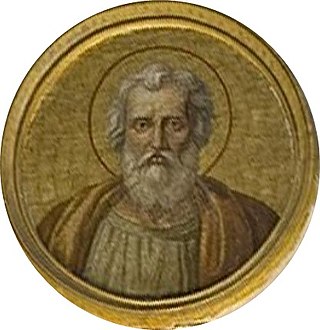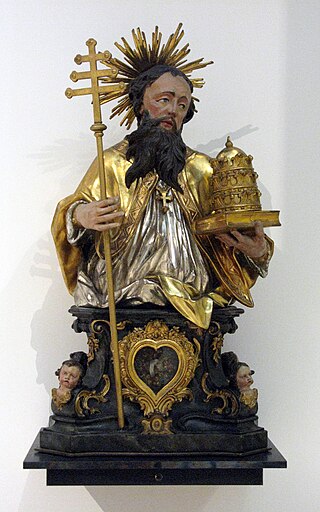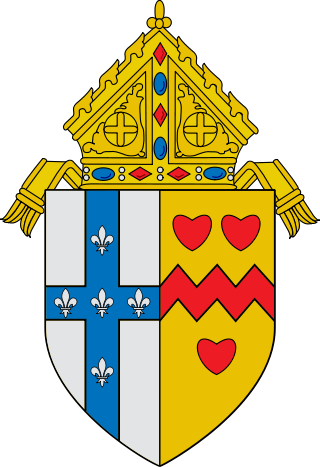
Antipope Felix was a Roman archdeacon in the 4th century who was installed irregularly in 355 as an antipope and reigned until 365 after Emperor Constantius II banished the then current pope, Liberius. Constantius, following the refusal of the laity to accept Felix, attempted to have them co-rule, but Felix was forced to retire. He was resented in his lifetime but has enjoyed a more popular memory since. In the Roman Catholic Church, an antipope described any figure attempting to oppose the legitimately elected Bishop of Rome.

Pope Linus was the bishop of Rome from c. AD 67 to his death. As with all the early popes, he was canonized.

Pope Anacletus, also known as Cletus, was the bishop of Rome, following Peter and Linus. Anacletus served between c. AD 79 and his death, c. AD 92. Cletus was a Roman who, during his tenure as pope, ordained a number of priests and is traditionally credited with setting up about twenty-five parishes in Rome. Although the precise dates of his pontificate are uncertain, he "...died a martyr, perhaps about 91". Cletus is mentioned in the Roman Canon of the mass; his feast day is April 26.
Pope Liberius was the bishop of Rome from 17 May 352 until his death. According to the Catalogus Liberianus, he was consecrated on 22 May as the successor to Pope Julius I. He is not mentioned as a saint in the Roman Martyrology. That makes him the earliest pontiff not to be venerated as a saint in the Roman Rite and one of only two popes to be omitted from Roman Catholic sainthood in the first 500 years of church history.

Saint Valentine was a 3rd-century Roman saint, commemorated in Western Christianity on February 14 and in Eastern Orthodoxy on July 6. From the High Middle Ages, his Saints' Day has been associated with a tradition of courtly love. He is also a patron saint of Terni, epilepsy and beekeepers. Saint Valentine was a clergyman – either a priest or a bishop – in the Roman Empire who ministered to persecuted Christians. He was martyred and his body buried on the Via Flaminia on February 14, which has been observed as the Feast of Saint Valentine since at least the eighth century.

St Mellons is a district and suburb of eastern Cardiff, the capital city of Wales. Prior to 1996 St Mellons was the name given to the community largely north of Newport Road (B4487) which included the old St Mellons village. After 1996 the old community was divided and renamed as Old St Mellons and Pontprennau, with the newer, much larger area of modern housing and business parks to the south of Newport Road retaining the St Mellons name. Historically in Monmouthshire, St Mellons became part of South Glamorgan and Cardiff in 1974.

August 1 - Eastern Orthodox liturgical calendar - August 3

August 4 - Eastern Orthodox liturgical calendar - August 6
Philip Evans and John Lloyd were Welsh Roman Catholic priests. They are among the Forty Martyrs of England and Wales.

January 8 – Eastern Orthodox liturgical calendar – January 10
The Archbishopric of Vienne, named after its episcopal seat in Vienne in the Isère département of southern France, was a metropolitan Roman Catholic archdiocese. It is now part of the Archdiocese of Lyon.

Saint Melaine was a 6th-century Bishop of Rennes in Brittany.

Felician(us) of Foligno is the patron saint of Foligno.

Calimerius was an early bishop of Milan. He is honoured as a Saint in the Catholic and Eastern Orthodox churches and his feast day is on July 31.

Eleutherius (or Eleut erus or Eleftherios; sometimes called Liberalis or Liberator, the former transliterations and the latter translations of his and his mother Antia are venerated as Christian saints and martyrs in Greece and Albania.

St Mary of the Angels Roman Catholic Church is located in Canton, Cardiff. It is part of the Roman Catholic Archdiocese of Cardiff. It opened on 3 November 1907.

October 21 - Eastern Orthodox liturgical calendar - October 23

The Personal Ordinariate of Our Lady of Walsingham in England and Wales is a personal ordinariate in the Latin Church of the Catholic Church immediately exempt, being directly subject to the Holy See. It is within the territory of the Catholic Bishops' Conference of England and Wales, of which its ordinary is a member, and also encompasses Scotland. It was established on 15 January 2011 for groups of former Anglicans in England and Wales in accordance with the apostolic constitution Anglicanorum coetibus of Pope Benedict XVI.

Saint Sanctinus of Meaux was a Gallo-Roman bishop and missionary, traditionally named as the first bishop of Meaux and also of Verdun.

St Mellons Parish Church, also previously called St Melan's church, is a Church in Wales parish church in the Diocese of Monmouth in Old St Mellons, Cardiff, Wales. It was built around the 13th century and is a Grade I listed building.














